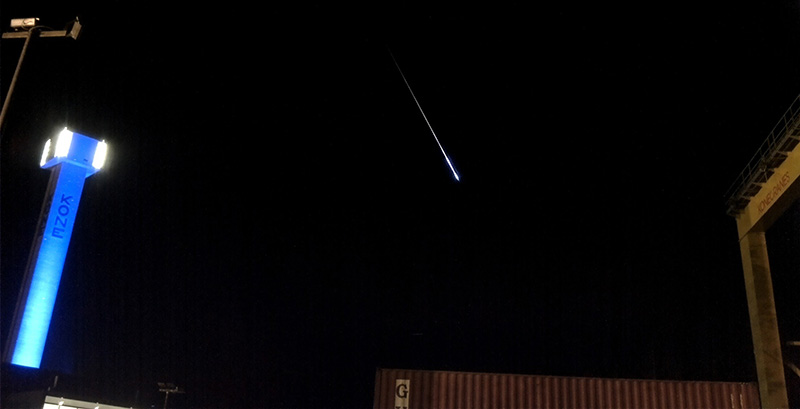
The Raspberry Pi is an incredibly popular, cheap, and low power computer that also has a nifty camera add-on that is completely programmable. This opens up a log of possibilities for long-exposure photography, and [Jippo] has found the best use so far: long exposure astrophotography for capturing meteors, satellites, and star trails.
[Jippo] is using a stock Raspi and camera module with a little bit of custom software written by his friend [Jani Lappalainen] that grabs image data from the camera and saves it either as a time-lapse, or only when something significantly changes. This would include meteors and Iridium flares, as well as passing planes, reflections of satellites, and of course long-exposure star trails.
So far, [Jippo] has already captured enough images to amount to a great night of skywatching. There’s a great picture of a meteor, a few pictures of satellites reflecting the sun, and some great star trails. The software [Jippo] is using is available on his site along with a gallery of his highlight reel.
















I like that He’s used an rpi for this, if I had the camera module, I probably would have mine out every night doing the same thing. As it is, I currently use a DSLR to do the same thing. Here is a time lapse I put together a month or so ago of the night sky above northern NH. There are tons of things streaking around the sky, a lot of them satalites.
http://youtu.be/4JuuTf2ssao
I had my DSLR set for a 4s ISO100 exposure every 5s using a f1.8 35mm lens.
Have you tried using a Raspi running gphoto on a Raspi to control your DSLR?
At first I tried using a Raspi running gphoto to control my camera, but the cable was a cm too short to reach. So I put my Raspi running gphoto on a Raspi, and now it works. Raspi is my platform of choice!
I have, but there really is no point. My dslr, D7000, has virtually every feature built into it, including a fully customizable intervalometer. All the raspi would be doing is acting as an override to the camera’s internal settings, and wouldn’t actually add any additional features. The only thing it might do is allow me to shoot an exposure longer than 30s, which I can already do with my $10 wired remote shutter with its own intervalometer. But outside of astrophotography on an tracking equatorial mount, exposures over 30s are really pointless. Even at the lowest ISO setting your going to get serious over exposures unless your working with a high f stop, and even then that would only be good for star trails.
If I really need to use an external controller for this type of work, I use my old Galaxy S3 running DslrDashboard with a USB OTG cable hooked straight to the camera. That provides all the camera controls on screen plus a live monitor from the camera’s image sensor for really good focus adjustments.
I think if I ever did use a raspi for this kind of work, it would be on its own with its own camera module in a remote area where there was little light pollution. I’m OK with losing a $35 raspi in the woods, it would be a huge bummer to do the same with my $1200 DSLR.
i cant seem to recall where i saw it but there is a program of multiple networked sky pointing cameras that are mapping trajectory info of meteors by angle and speed of the streaks in the sky. would be neat to see if a rpi could be fashioned into a cheap astrotelemetry gathering device
Program run by NASA All Sky Fireballs.
http://fireballs.ndc.nasa.gov/
There is similar network in Europe: https://en.m.wikipedia.org/wiki/European_Fireball_Network
A few years ago saw one of those change direction. In the day. Over a suburban area. It landed.
It just appeared out of the blue sky and made its way towards the ground in a very non-ballistic, non-aerodynamic trajectory. It looked like a bright, silvery white point, perhaps the size of a soccer ball. I think it was ball lightning. I estimate the energy output of the light to have been non-trivial. The best physical explanation I can come up with for the phenomena is a plasma toroid sustained by a natural fusion phenomena. If that is correct then the scale estimation for the Tokamak is completely wrong.
He really needs to print up an adapter and mount that camera to some real optics. Anything over a minute should be showing a significant amount of starlight and skyglow. Those images look like they were taken through a pinhole.
I’ve thought of doing the exact same thing, but with the incredibly small sensor size in the raspi camera module, he would be getting some serious image cropping leading to a really small field of view if he didn’t use corrective optical elements. Unless you mean using some 16mm thread security camera lenses, then you could get a pretty good field of view, but these lenses are not made for low light, and their optical quality is almost always quite bad oweing to their use in low resolution security cameras. As for the pin hole feel to the images…. Well the raspi camera module has really small fixed lens, which would explain the pin hole effect.
I have an adaptor for the Pi Camera module to telescope draw tubes here.
http://www.thingiverse.com/thing:181310
However, the Field Of View is extremely small on any reasonably-sized telescope (i.e. looking at part of the Moon instead of looking at wide swaths of sky.)
Where are the sources ?
I would like to make longer exposures.
3600 seconds is max so why need more?
Raspberry Pi is amazing and can do so much – it is a great tool for kids who are learning technology. And clearly it can do a lot more.